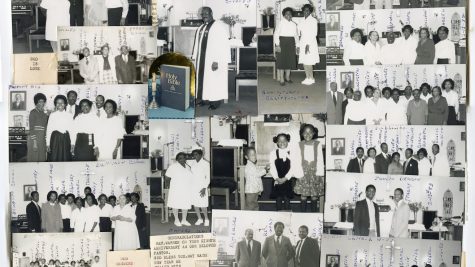Opinion ||: Latino Students Deserve Inclusion on Campus
In the early 2000s, there were just a little over 250 Hispanic/Latino students on campus. Since Fall 2014, that number has tripled to over 750 Hispanic students. That is progress. Going forward, American University should continue to recruit Hispanic/Latino students. As a Latino student, it would give me much pride to see AU further tap into my community’s incredible potential.
However, diversifying the student population is just the beginning. There’s something more important than having a higher number next to “Hispanic/Latino” in the diversity tab on collegeboard.com and that’s creating an inclusive campus.
Latino students deserve to feel a sense of belonging to an institution where we spend four years of our lives, a place where many of us want to call our home, but many times can’t because it doesn’t always feel like we are cared for or wanted. There are lots of changes AU can implement right now to begin the work of Latino inclusion.
For starters, AU should make it easier for Latino students to celebrate their culture. One or more rooms in the third floor of MGC should be designated for cultural clubs such as Latino and American Student Organization (LASO), League of United Latin American Citizens (LULAC), the National Association for the Advancement of Colored People (NAACP) campus chapter and Black Student Alliance (BSA) so Latinos and other minority groups can have a central space to meet, organize and celebrate their communities. Additionally, the provost’s office should invest time and resources in creating more courses about Latino culture and history in all five schools. The library should also import more books and educational resources about Latino history and culture. These two proposals would help students of all races learn more about the community.
For many of us, we are the first in our family to go to college. As a first-generation student myself, I can say that navigating the entire college process was challenging. From the application process to the financial aid process, students like me have a difficult time understanding how these vital procedures work because our parents don’t know the process works. Both the student and their family are new to the process. AU Central in particular should invest time to figuring out how to best help first-generation students understand the financing process.
AU has more work to do than just increasing its student diversity. It’s barely even begun when it comes to faculty diversity. There is no other way to say it: when looking at the stats, AU is a white institution.
According to AU’s numbers, here is the racial breakdown of faculty at all schools, undergrad and grad and library faculty:
White: 76%
Hispanic: 4%
Black: 4%
Asian American/Pacific Islander: 8%
International/Permanent Residents: 5%
American Indian/Native American: A disturbing 0.1%.
The numbers claim Kogod has one Hispanic professor, School of Communication (SOC) has zero, School of International Service (SIS) has five, College of Arts and Sciences (CAS) has 25 and the School of Public Affairs (SPA) has one.
Including the Washington College of Law, there are a disappointing total of 36 Hispanic professors. That number could be inaccurate because it is unclear whether AU knows or assumes the race of a faculty member.
Some make the argument that the paltry number of Hispanic professors is due to the fact they are a minority and thus, naturally, there would be a small number teaching at institutions of higher education like AU. Although such an argument may make sense in theory, in reality there are many Hispanic professors readily employable. Not to mention, AU should reflect the diversity of the country that chartered it into existence. Seventeen percent of the U.S. population is Hispanic/Latino and this rate is rapidly growing, while at AU the rate of Hispanic professors has remained stagnant at four percent. This is especially infuriating when there has been a demand for more Hispanic professors for many years.
There is no other way of putting it: the provost’s office and the panels in charge of hiring faculty in each respective school have failed Latino students. They have failed students of color. They have ignored the community’s demands.
It seems as if the faculty hiring process takes place using the status quo model of hiring. Although on the university’s literature, AU claims to have an affirmative action hiring policy, the numbers do not reflect the full use of that policy. The provost’s office must implement a hiring strategy that will result in the hiring of more Latino professors by using affirmative action to the fullest extent.
Why is it important to have more Hispanic/Latino professors? First, the lack of diversity robs all students of a well-rounded education. By having more Latino professors, students will have an opportunity to learn about the experiences of Latino communities. It could also aid students in their understanding of DC, as local Hispanic professors could bring in expertise about DC’s long history with racial injustice. In academia, it’s always better to have more diverse voices to help achieve the whole point of college: learning.
Hiring Hispanic professors is especially important when it comes to SPA, a school that educates future politicians and their staff members. AU will be graduating students who will make government policy that will impact the lives of people, including Latinos. Policymakers should have a well-rounded understanding of all types of communities in order to advocate for just policies.
For example, Homeland Security and U.S. Immigration and Customs Enforcement agency (ICE) are currently conducting immigration raids. If there were a strong majority of members of Congress who fought to block the raids, we wouldn’t be seeing as many people being sent to their death sentence when they are deported back to their countries. If these lawmakers had more Hispanic people in their lives or had learned more about the Hispanic community from someone during their formative years, like a professor, it is more likely that they would be understanding of the community’s struggles and have second thoughts about ripping apart families.
Also, Latino students deserve to have professors to whom they can relate. On a personal note, it would be really nice just to talk to my professor about Latino family quirks and have them understand or express my irritations with the xenophobia and racism coming from many of the presidential candidates and have them get it. Unfortunately, there are almost no Hispanic professors to do that with.
Furthermore, hiring more Hispanic professors would help the community as a whole because more of them would be hired at a nationally ranked institution. It would also bring increased visibility to the fact that Hispanics are more than the stereotypical roles society perpetuates. By hiring more Hispanic professors, the role of a Hispanic person in academia would be further redefined for the better. In their everyday classes, students would see more Hispanics in a traditionally white profession.
Implementing these proposals is not just meant to make Latino students “feel nice,” as some might think. It’s about whether or not, at its core, AU is an institution that cares about inclusion and fairness. It’s about truly and fully including Latino students at an institution that was initially never meant for us.
*Note: The use of the terms Hispanic and Latino are not necessarily interchangeable. Hispanic is defined as someone of origin of a Spanish-speaking country. Latino is defined as someone who originates from Latin American. The terms frequently overlap but there is a distinction.












